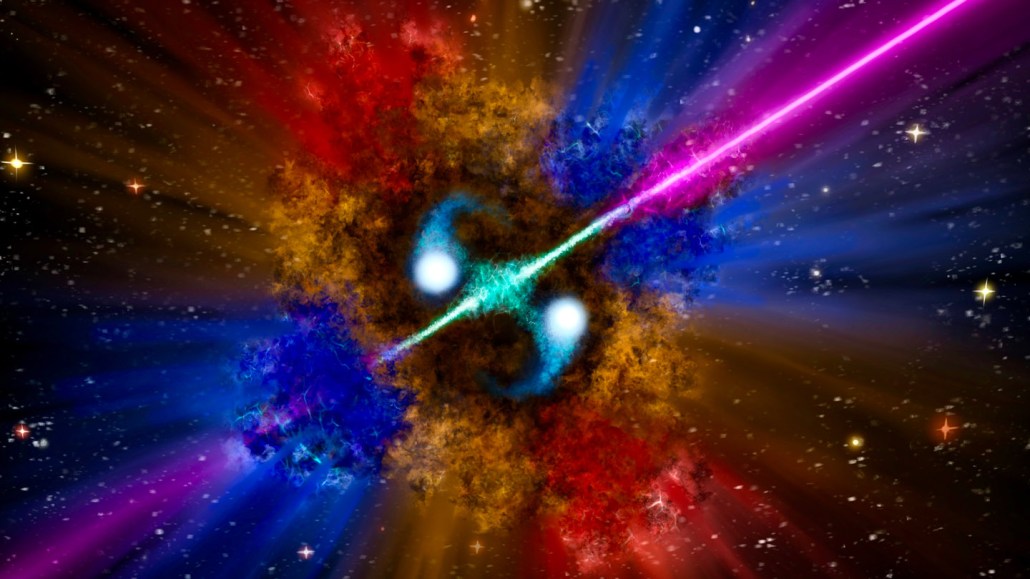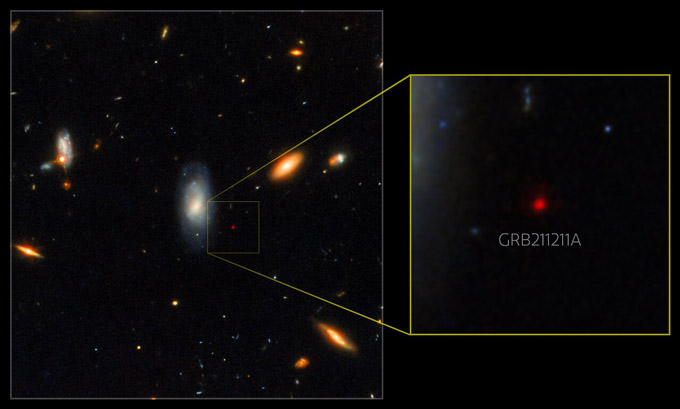
One possible origin for GRB 211211A, shown in this illustration, is a pair of compact stars merging (bright dots in the center) and emitting jets of radiation (green and purple beams). Heavy elements forming in the clouds of matter surrounding the stars emit light that is known as a kilonova.
Samuele Ronchini/GSSI 2022
- More than 2 years ago
Astronomers have spotted a bright gamma-ray burst that upends previous theories of how these energetic cosmic eruptions occur.
For decades, astronomers thought that GRBs came in two flavors, long and short — that is, lasting longer than two seconds or winking out more quickly. Each type has been linked to different cosmic events. But about a year ago, two NASA space telescopes caught a short GRB in long GRB’s clothing: It lasted a long time but originated from a short GRB source.
“We had this black-and-white vision of the universe,” says astrophysicist Eleonora Troja of the Tor Vergata University of Rome. “This is the red flag that tells us, nope, it’s not. Surprise!”
This burst, called GRB 211211A, is the first that unambiguously breaks the binary, Troja and others report December 7 in five papers in Nature and Nature Astronomy.
Prior to the discovery of this burst, astronomers mostly thought that there were just two ways to produce a GRB. The collapse of a massive star just before it explodes in a supernova could make a long gamma-ray burst, lasting more than two seconds (SN: 10/28/22). Or a pair of dense stellar corpses called neutron stars could collide, merge and form a new black hole, releasing a short gamma-ray burst of two seconds or less.
But there had been some outliers. A surprisingly short GRB in 2020 seemed to come from a massive star’s implosion (SN: 8/2/21). And some long-duration GRBs dating back to 2006 lacked a supernova after the fact, raising questions about their origins.
“We always knew there was an overlap,” says astrophysicist Chryssa Kouveliotou of George Washington University in Washington, D.C., who wrote the 1993 paper that introduced the two GRB categories, but was not involved in the new work. “There were some outliers which we did not know how to interpret.”
There’s no such mystery about GRB 211211A: The burst lasted more than 50 seconds and was clearly accompanied by a kilonova, the characteristic glow of new elements being forged after a neutron star smashup.

“Although we suspected it was possible that extended emission GRBs were mergers … this is the first confirmation,” says astrophysicist Benjamin Gompertz of the University of Birmingham in England, who describes observations of the burst in Nature Astronomy. “It has the kilonova, which is the smoking gun.”
NASA’s Swift and Fermi space telescopes detected the explosion on December 11, 2021, in a galaxy about 1.1 billion light-years away. “We thought it was a run-of-the-mill long gamma-ray burst,” says astrophysicist Wen-fai Fong of Northwestern University in Evanston, Ill.
It was relatively close by, as GRBs go. So that allowed Fong’s and Troja’s research groups to independently continue closely observing the burst in great detail using telescopes on the ground, the teams report in Nature.
As the weeks wore on and no supernova appeared, the researchers grew confused. Their observations revealed that whatever had made the GRB had also emitted much more optical and infrared light than is typical for the source of a long GRB.
After ruling out other explanations, Troja and colleagues compared the burst’s aftereffects with the first kilonova ever observed in concert with ripples in spacetime called gravitational waves (SN: 10/16/17). The match was nearly perfect. “That’s when many people got convinced we were talking about a kilonova,” she says.
In retrospect, it feels obvious that it was a kilonova, Troja says. But in the moment, it felt as impossible as seeing a lion in the Arctic. “It looks like a lion, it roars like a lion, but it shouldn’t be here, so it cannot be,” she says. “That’s exactly what we felt.”
Now the question is, what happened? Typically, merging neutron stars collapse into a black hole almost immediately. The gamma rays come from material that is superheated as it falls into the black hole, but the material is scant, and the black hole gobbles it up within two seconds. So how did GRB 211211A keep its light going for almost a minute?
It’s possible that the neutron stars first merged into a single, larger neutron star, which briefly resisted the pressure to collapse into a black hole. That has implications for the fundamental physics that describes how difficult it is to crush neutrons into a black hole, Gompertz says.
Another possibility is that a neutron star collided with a small black hole, about five times the mass of the sun, instead of another neutron star. And the process of the black hole eating the neutron star took longer.
Or it could have been something else entirely: a neutron star merging with a white dwarf, astrophysicist Bing Zhang of the University of Nevada, Las Vegas and colleagues suggest in Nature. “We suggest a third type of progenitor, something very different from the previous two types,” he says.
White dwarfs are the remnants of smaller stars like the sun, and are not as dense or compact as neutron stars. A collision between a white dwarf and a neutron star could still produce a kilonova if the white dwarf is very heavy.
The resulting object could be a highly magnetized neutron star called a magnetar (SN: 12/1/20). The magnetar could have continued pumping energy into gamma rays and other wavelengths of light, extending the life of the burst, Zhang says.
Whatever its origins, GRB 211211A is a big deal for physics. “It is important because we wanted to understand, what on Earth are these events?” Kouveliotou says.
Figuring out what caused it could illuminate how heavy elements in the universe form. And some previously seen long GRBs that scientists thought were from supernovas might actually be actually from mergers.
To learn more, scientists need to find more of these binary-busting GRBs, plus observations of gravitational waves at the same time. Trejo thinks they’ll be able to get that when the Laser Interferometer Gravitational-Wave Observatory, or LIGO, comes back online in 2023.
“I hope that LIGO will produce some evidence,” Kouveliotou says. “Nature might be graceful and give us a couple of these events with gravitational wave counterparts, and maybe [help us] understand what’s going on.”







